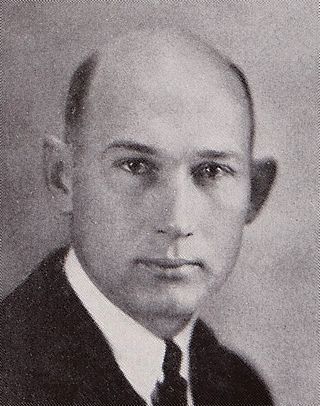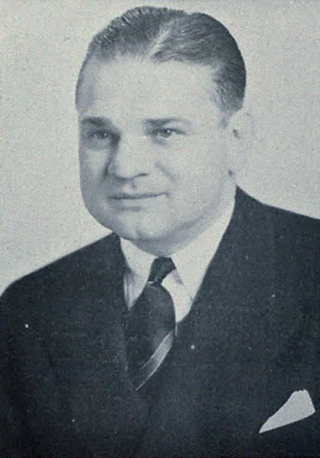
Fielding Harris Yost was an American college football player, coach and athletics administrator. He served as the head football coach at: Ohio Wesleyan University, the University of Nebraska, the University of Kansas, Stanford University, San Jose State University, and the University of Michigan, compiling a coaching career record of 198–35–12. During his 25 seasons as the head football coach at Ann Arbor, Yost's Michigan Wolverines won six national championships, captured ten Big Ten Conference titles, and amassed a record of 165–29–10.

Michigan Stadium, nicknamed "The Big House," is the football stadium for the University of Michigan in Ann Arbor, Michigan. It is the largest stadium in the United States and the Western Hemisphere, the third-largest stadium in the world, and the 34th-largest sports venue in the world. Its official capacity is 107,601, but it has hosted crowds in excess of 115,000.

Benjamin Friedman was an American football player and coach, and athletic administrator.

The Michigan Wolverines comprise 29 varsity sports teams at the University of Michigan. These teams compete in the NCAA's Division I and in the Big Ten Conference in all sports except women's water polo, which competes in the NCAA inter-divisional Collegiate Water Polo Association. Team colors are maize and blue, though these are different shades of "maize" and "blue" from those used by the university at large. The winged helmet is a recognized icon of Michigan Athletics.

Benjamin Oosterbaan was an American football end and head coach for the University of Michigan. He was a three-time All-American college football player, a two-time All-American basketball player, and an All-Big Ten Conference baseball player for the Michigan Wolverines. He is widely regarded as one of the greatest football players in Michigan history. He was selected by Sports Illustrated as the fourth greatest athlete in the history of the U.S. state of Michigan in 2003, and one of the eleven greatest college football players of the first century of the game. As a head coach Oosterbaan won a national championship with the 1948 Michigan Wolverines football team, by way of the Associated Press.

Ferry Field is a multi-purpose stadium in Ann Arbor, Michigan. It opened in 1906 and was home to the Michigan Wolverines football team prior to the opening of Michigan Stadium in 1927. It had a capacity of 46,000. It is currently used as a tailgating space for football games.

The Michigan Wolverines football team represents the University of Michigan in college football at the NCAA Division I Football Bowl Subdivision level. Michigan has the most all-time wins in college football history. The team is known for its distinctive winged helmet, its fight song, its record-breaking attendance figures at Michigan Stadium, and its many rivalries, particularly its annual, regular season-ending game against Ohio State, known simply as "The Game," once voted as ESPN's best sports rivalry.

Elton Ewart "Tad" Wieman was an American college football player and coach and athletics administrator. He played football for the University of Michigan from 1915 to 1917 and 1920 under head coach Fielding H. Yost. He was a coach and administrator at Michigan from 1921 to 1929, including two years as the school's head football coach. Wieman served as a football coach at the University of Minnesota from 1930 to 1931, Princeton University from 1932 to 1942, and Columbia University from to 1945, and as an athletic director at the University of Maine from 1946 to 1951 and the University of Denver from 1951 to 1962. He was inducted into the College Football Hall of Fame as a coach in 1956.

Ferry Field was the home field for the University of Michigan football team from 1893 to 1905. It was located along South State Street in Ann Arbor, Michigan, where Schembechler Hall stands today.

W. Henry Hatch was the equipment manager for the University of Michigan varsity sports programs for 43 years from 1921 to 1964. For many years, he lived with his wife and daughter in a house on the grounds of Michigan Stadium and was considered a legendary figure in Michigan sports history. The Hatch-Falk Award is named in his honor, and he was posthumously inducted into the University of Michigan Athletic Hall of Honor in 1992. Hatch is responsible for the tradition of retiring Michigan Wolverines football jerseys and is part of the lore of the Little Brown Jug.

Charles A. Baird was an American football manager, university athletic director, and banker.

The 1925 Michigan Wolverines football team represented the University of Michigan in the 1925 Big Ten Conference football season. The 1925 season was Fielding H. Yost's 24th as the head football coach. Michigan compiled a 7–1 record and outscored opponents by a combined score of 227 to 3. The 1925 team won the Big Ten Conference championship and was ranked second in country behind Dartmouth in the Dickinson System rankings.
The 1926 Michigan Wolverines football team represented the University of Michigan in the 1926 Big Ten Conference football season. In the team's 25th and final season under head coach Fielding H. Yost, Michigan compiled a record of 7–1, outscored its opponents 191 to 38, and tied with Northwestern for the Big Ten Conference championship. Michigan's only loss was to an undefeated Navy team that was recognized as the national champion by several selectors. At the end of the season, Michigan ranked third in the country under the Dickinson System, trailing only Stanford and Navy. One selector, Jeff Sagarin, has retroactively named Michigan as a 1926 co-national champion.
The 1934 Michigan Wolverines football team was an American football team that represented the University of Michigan in the 1934 Big Ten Conference football season. In their sixth season under head coach Harry Kipke, the Wolverines compiled a 1–7 record and finished last in the Big Ten. Prior to the 1934 season, the Wolverines had compiled a 22-game undefeated streak dating back to October 1931.

The 1928 Michigan Wolverines football team was an American football team that represented the University of Michigan in the 1928 Big Ten Conference football season. The Wolverines compiled a 3–4–1 record, tied for seventh place in the Big Ten, and were outscored by their opponents by a total of 62 to 36.

The 1927 Michigan Wolverines football team represented the University of Michigan in the 1927 Big Ten Conference football season. The 1927 season was Michigan's first in its new stadium, Michigan Stadium. It was also the first under new head coach Tad Wieman following the retirement of Fielding H. Yost as head coach. Michigan shut out its first four opponents before losing to 1927 Big Ten Conference champion Illinois and later to Big Ten runner up Minnesota. Michigan compiled a record of 6–2 and outscored its opponents by a combined score of 137 to 39. The team was ranked No. 7 in the nation in the Dickinson System ratings released in December 1927.

Louis Matthew Gilbert was an American football player. He played at the halfback position for the Michigan Wolverines football teams from 1925 to 1927. He was selected as a first-team All-Big Ten Conference player in 1927 and was selected by Fielding H. Yost in 1941 as the greatest punter of all time.

The History of Michigan Wolverines football in the Yost era covers the period from the hiring of Fielding H. Yost as head coach in 1901 through Yost's firing of Tad Wieman as head coach after the 1928 season. The era includes the brief head coaching tenures of George Little and Tad Wieman. Wieman was head coach during the 1927 and 1928 seasons but contended that he had never truly been allowed to take control of the team with Yost remaining as an assistant coach and athletic director.

The history of Michigan Wolverines football in the Kipke years covers the history of the University of Michigan Wolverines football program during the period from the hiring of Harry Kipke as head coach in 1929 through his firing after the 1937 season. Michigan was a member of the Big Ten Conference during the Kipke years and played its home games at Michigan Stadium.

















